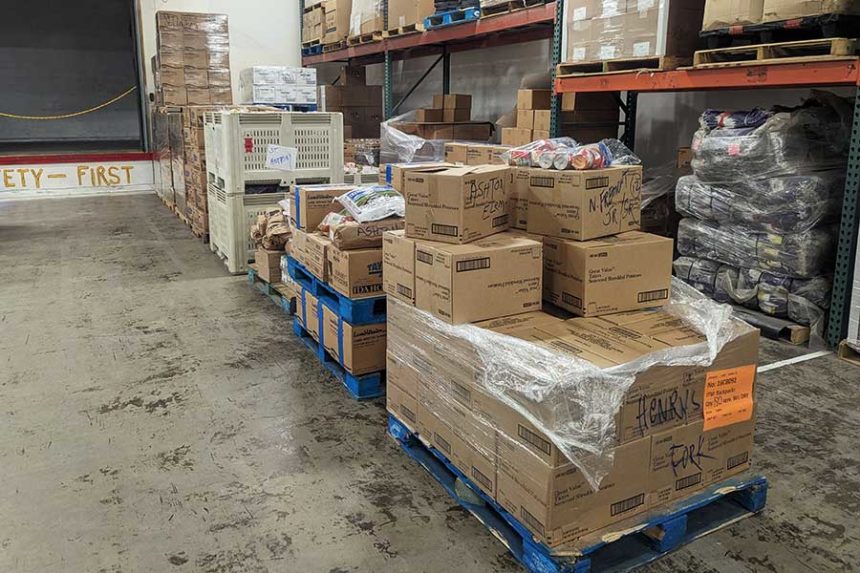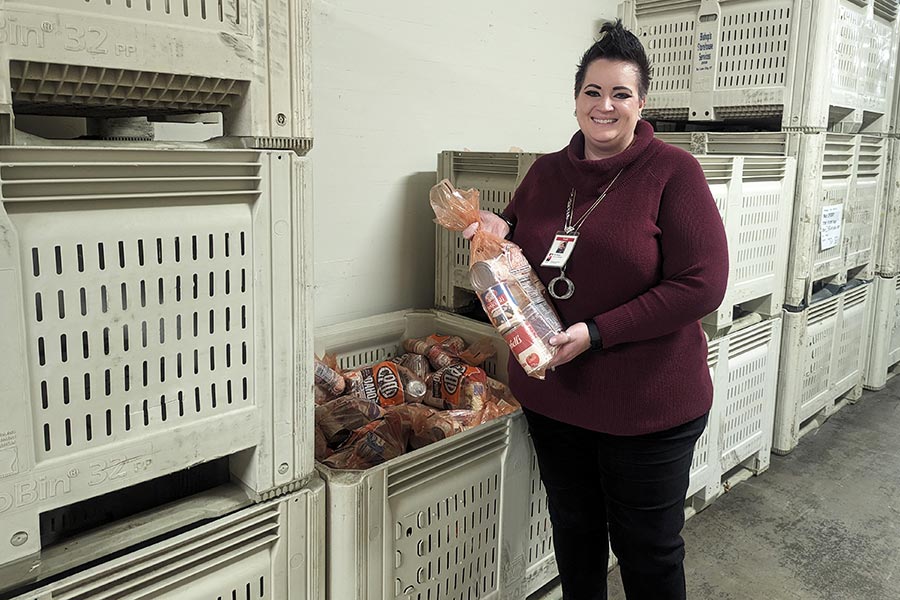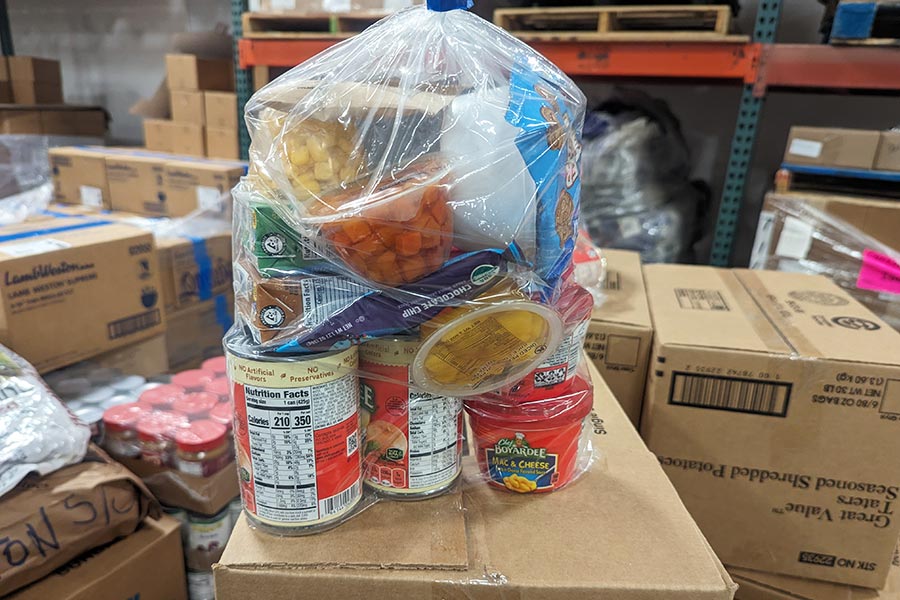What is the Idaho Foodbank? How does it work and who does it help?
Published at | Updated at
POCATELLO — The Idaho Foodbank is a non-profit organization that distributed food to, on average, around 53,000 people per month last year in eastern Idaho.
Because of the name, according to eastern branch manager Kia Shaw, many people incorrectly assume the food bank is a state government entity, using tax dollars to feed its recipients — or, as she called them, “neighbors.” But the organization receives no government funding — outside of the occasional grant. Instead, it gets around half of its funding through donations from private individuals.
“We do have foundations, trusts and corporations that we work with, but it’s really individuals who are supporting us,” Shaw told EastIdahoNews.com.
RELATED | Local food banks dealing with increase in demand, decrease in supply
While food insecurity is a year-round problem many Idahoans face — 8.2% of the state, Shaw said — this time of year brings an even higher demand for the work of food banks.
Shaw gave EastIdahoNews.com a peek behind the veil, explaining the work the food bank does, and how its employees and volunteers go about doing that work.

How it works
The Idaho Foodbank has three facilities in Idaho — Meridian, which distributes in the western part of the state, Lewiston, which distributes up north, and Pocatello. The Pocatello facility, Shaw explained, distributes food to partner agencies, like the Idaho Falls Community Food Basket, in 16 counties — Custer, Lemhi, Butte, Clark, Fremont, Teton, Madison, Jefferson, Bonneville, Bingham, Bannock, Power, Caribou, Oneida, Franklin and Bear Lake.
Though people in need of food are able to pick up “emergency food bags” from the Pocatello facility, their work focuses primarily on getting food to partner agencies and mobile pantries.
Shaw and her team seek out donations, food drive opportunities and the best possible deals for bulk food purchases. That food is then boxed up and shipped, by pallet, to the partner agencies — of which the food bank assists 482 across the state.
The food they look for
The food bank is focused on delivering food to help its neighbors prepare nutritious and well-balanced meals — based on U.S. Department of Agriculture My Plate guidelines.
Using the My Plate structure, 86% of all food distributed last year by The Idaho Foodbank was classified as “nutritious,” according to Shaw.
The food bank, she explained, looks for canned foods that are low in sodium, with fruits and vegetables canned in natural juices or water — as opposed to being canned in syrup.
Of course, fresh produce is always healthier, so the food bank has worked out deals with local growers — in Idaho, Oregon and Washington — to provide its neighbors with fresh fruit and vegetables.
“It’s stuff that is the most expensive stuff in the grocery store, but it’s also the best thing for you,” Shaw said of fresh produce.
During the 2023 fiscal year, 25% of all food distributed by The Idaho Foodbank was fresh produce, she added.
One big supplier of the fresh produce offered by the food bank is — perhaps surprisingly — the Idaho Department of Correction’s men’s prison in Kuna.
Several years ago, the food bank and prison formed a partnership through which prisoners planted, cultivated and harvested fruits and vegetables which were then provided to the food bank.
That program, however, was shut down during COVID-19, but is due to return in 2024.
Shaw, who has been with the food bank for seven years, could not provide details about the amount of produce provided through that partnership, but said it was a significant amount.
Though its focus is on providing nutritious foods, The Idaho Foodbank is happy to accept snack foods. As Shaw explained, it is not her or the organization’s job to regulate recipients’ diet — and with many of the recipients feeding children with the programs, snacks, sometimes unhealthy, are a necessity.
“When you have a little one and they’re going through your pantry and they get to pick out a snack, that gives not only you that sense of pride and dignity it gives your child that sense of normalcy when they’re at school around their friends,” Shaw said.
Special programs
The Idaho Foodbank runs several special programs — two of which are very near and dear to Shaw’s heart.
One targets senior citizens suffering through food insecurity.
Boxes, specially packed for seniors containing cheese, milk, soup, fruits, vegetables and grains, are distributed to 2,200 seniors across the state monthly. There is an application process for seniors before they are eligible to receive these boxes, though Shaw said the process is relatively easily.
There is also a waitlist, one the food bank is constantly working through.
Another program — the “Backpack Program” — is designed to assure children have food to get through the weekends, when they don’t have access to school meals.
These food bags each contain two breakfasts, lunches, dinners, snacks, juices and milks — all “nutritious,” microwavable and in easy-open containers. They are also designed to weigh no more than seven pounds, so they can be thrown into the child’s backpack without the potential of causing injuries.
“Kiddos shouldn’t have to worry about where their food is coming from, period,” Shaw said. “If you’re a child, you should worry about having fun and learning — those are the two things in life you should really be concerned about. And these (seniors) are individuals who have paid their dues to society — who are having to make choices between paying for the medication that they need or paying for food, paying for rent or food, paying for utilities or food.”

Partnerships
The Idaho Foodbank has formed partnerships with similar agencies in other states, in order to expand the types of food they are able to offer. They have also formed partnerships with food distributors, who offer food items at massive discounts.
One of the partnerships Shaw is especially grateful for is one with Lamb Weston, in Idaho Falls.
Along with the food they provide, Lamb Weston helps with one of the many hidden costs associated with the food bank — cardboard boxes.
Between foods that they are, for any number of reasons, not able to sell and the pallets of boxes the Pocatello food bank receives from the food distributor, Shaw said, she saves “tens of thousands of dollars” through the partnership with Lamb Weston.
“That’s money that we can now spend on food instead,” Shaw said. … “(Lamb Weston) has been a life-saver, in more than one way, when it comes to supporting us.”
Another huge partnership Shaw gushed over is the one the food bank has with the community.
Because it is a non-profit organization, The Idaho Foodbank runs with a very limited staff. According to Shaw, there are 10 full-time employees receiving, sorting, boxing and shipping food to dozens of food distribution agencies from Montpelier to Salmon.
The only way they are able to do so, she said, is through the assistance of volunteers.
Shaw told EastIdahoNews.com that, on a weekly basis, volunteers contribute work hours equivalent to that of eight additional full-time employees.
“I could never hire that many employees — they do a lot of work and I am so grateful,” she said.
Other services offered
Among the limited staff at The Idaho Foodbank are qualified dietitians, who create meals from available food items.
According to Shaw, the food bank will occasionally get items with limited known use options.
One example she offered was garbanzo beans, which the food bank received in bulk recently. Rather than just handing out cans of garbanzo beans and hoping recipients would be able to make edible hummus, the dietitians created samples of other meals that could be prepared using the beans and other items provided. Recipients tried those meals and received the items needed to recreate them.
The food bank, and those dietitians, also run a program called “cooking matters.”
This program, Shaw said, is a six-week class during which participants learn basic kitchen and cooking skills, as well as skills for smart shopping. They learn to shop the fresh food sections of grocery stores, finding the best prices for items that fit their families’ dietary needs.
A huge part of these skills, Shaw added, is using the food bank and SNAP food stamp benefits together to properly feed their family.
Participants learn to prepare meals from scratch — because it is the cheapest way, Shaw explained.
The course ends with participants receiving a $10 gift card with the task of shopping for and preparing a meal for four.
As Shaw explained, the entire food bank industry is built on the idea of stretching ever dollar — and teaching neighbors to do the same — when it comes to food.
The number of people in need of assistance, she added, has grown. More than 150,000 Idahoans currently live through what is classified as food insecurity — which means they do not know where their next meal is coming from.
And Shaw is quick to point out that it is not just people who do not work.
As she said, many of the recipients of the food bank’s programs work one, two or sometimes three jobs.
In this state, according to Shaw, it takes someone being paid minimum wage 95 hours of paid work per week to afford housing. With rising costs of food, among all other things, it is important for organizations like The Idaho Foodbank to continue its work.
It is also important, Shaw added, that people in need of the assistance know it is there for them.
Anyone in need of food can find a complete list of food distributions agencies on the Idaho Foodbank’s website — here.
You can also find out how to donate or volunteer at the same site.


